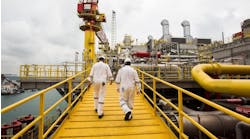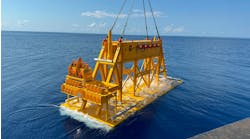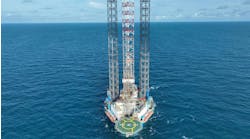Sevan’s new platform type makes breakthrough in Brazil
Sevan Marine has signed a letter of intent with Petrobras for the lease of an SSP - Sevan stabilized platform - to produce the Piranema field offshore Brazil. The charter has a fixed term of 11 years and is worth an estimated $399 million, according to President Jan Erik Tveteraas, who expects to sign the contract later in the year.
The SSP, a monohull with a circular shape, is not unique to Sevan, but the company is the first to win acceptance for a circular monohull from a user. The circular form offers several advantages compared with the ship-shape of existing FPSOs, Sevan says. One of the most important advantages is that it does not need a turret to moor it or a swivel for fluid transfer. Instead, it is spread moored.
This feature provides considerable cost savings in design and construction, not to mention the avoidance of the technical challenges often associated with turrets, the company says. And the marine crew required for an SSP is smaller than that needed on a shipshape FPSO, Tveteraas says.
The spar platform is also a circular structure, but differs from the SSP is that its depth is much greater than its diameter. This gives it very different and more complex motions compared with the SSP, which has a depth much less than its diameter. In the case of SSP Piranema, the diameter is 60 m and the depth 30 m. Unlike the spar, the SSP provides oil storage in its hull.
Other benefits of the SSP include a high variable deckload - 2,500-3,000 tons in the case of SSP Piranema - and relatively simple construction, requiring much less piping and cabling than a shipshape FPSO. The motions are very favorable, due to the circular shape and a motion-damping bilge keel. Sevan has filed two patent applications for its design, in 2001 and 2003.
DNV has verified the design and assessed risk for the first SSP, and LabOcean in Rio de Janeiro and Marintek in Trondheim model tested it.
Range of sizes
The Piranema unit is designated SSP300, indicating that it has 300,000 bbl storage. Its dimensions are suited to a small or medium size field, with production of up to 50,000 b/d, says Tveteraas. By increasing the dimensions, much greater capacities can be achieved. The largest version developed so far is the SSP2000, which with a diameter of 106 m and depth of about 33 m provides production capacity of 200,000 b/d and 2 MMbbl storage.
All sizes of the SSP are designed for construction on land and skidding onto a barge for transportation and launching.
SSP Piranema is already under construction at the Yantai Raffles shipyard in China. The order was placed on speculation in March 2004, an indication of Sevan’s confidence in its technology. In February about one third of the steel had been cut. The hull weighs 8,500-9,500 tons and the topsides some 2,500 tons.
Sevan’s contract also includes the provision of topsides facilities and operation of the unit. In addition to separation equipment and oil processing, these include a gas injection plant with compression capacity of 3.6 MMcm/d - gas will be reinjected, as it cannot be flared. Norwegian company Kanfa, which specializes in the design of process equipment, is carrying out the facility engineering. Early this year, Sevan acquired a 48% stake in Kanfa to secure long-term access to this capability.
The platform is scheduled to leave the Yantai Raffles yard in early 2006, when it will be dry-towed to Brazil. Here, it will be moored on the field, which is off the northeast coast of Sergipe, probably with nine mooring lines divided into three clusters. Field installation and commissioning should be straightforward and is not expected to take long.
The platform will be equipped to accommodate up to 21 risers, which will be suspended from the SSP. As with a conventional FPSO, oil will be exported via a hose directly to shuttle tankers.
Water depth at the initial location is about 1,000 m. As the reservoir is depleted, the platform will be moved to different locations in depths of up to 1,600 m. The charter includes extension options, as production could continue for up to 15-20 years.
Brazil focus
Sevan identified Brazil as offering opportunities for its platform concept at an early stage, and established a Brazilian subsidiary, Sevan Marine do Brasil Ltda, shortly after the company itself was founded in 2001. It also works closely with a Brazilian contractor, Etesco Construção e Comércio Ltda, which is to take a 25% equity interest in SSP Piranema.
Petrobras responded positively to Sevan’s approaches, as it was already interested in developing new monohull FPSO concepts, and in July last year the two companies signed a technical cooperation agreement to exchange knowledge and experience related to the design and construction of monohull units. This was followed in autumn 2004 by a memorandum of understanding for using the SSP to produce Piranema.
With first use of the SSP now in the pipeline, Tveteraas is optimistic about finding other customers for the SSP. Sevan’s marketing drive has aroused interest in the North Sea and Southeast Asian markets where it has been focused. It is probably in the North Sea, where existing FPSOs all have internal turrets, that the concept offers the greatest savings.




